Abstract
Cultured human NK cells and T cells grown in the presence of IL-2 and phytohaemagglutinin incorporated 35S sulphate into two distinct macromolecular species. The larger molecule was identified as a chondroitin-4-sulphate proteoglycan and was present in both cell-associated and secreted material. The smaller component was identified as free glycosaminoglycan and was present only in the cell-associated material. The sulphated macromolecules synthesized by NK cells were smaller than those produced by T cells. Growth in the presence of beta-D-xyloside led to a decrease in proteoglycan production, together with an increase in the synthesis of free glycosaminoglycan. The latter molecule was found in the secreted as well as the cell-associated fraction. In all instances, growth of T cells was inhibited by xyloside in a dose-dependent fashion. However, growth of NK cells from 3/7 donors was stimulated at low concentrations of xyloside (0.25 and 0.5 mM). Growth of NK cells in xyloside had no effect on their lytic activity, and the 'NK-like' cytolytic capacity of cultured T cells was similarly unaffected. Both NK cells and T cells grown in xyloside at a concentration resulting in a 50% inhibition of intact proteoglycan synthesis did not show increased susceptibility to autolysis in the presence of NK-cell targets. These findings suggest that optimal production of the intact proteoglycan molecule may not be essential for NK-cell lytic function or protection of effector cells in vitro.
Full text
PDF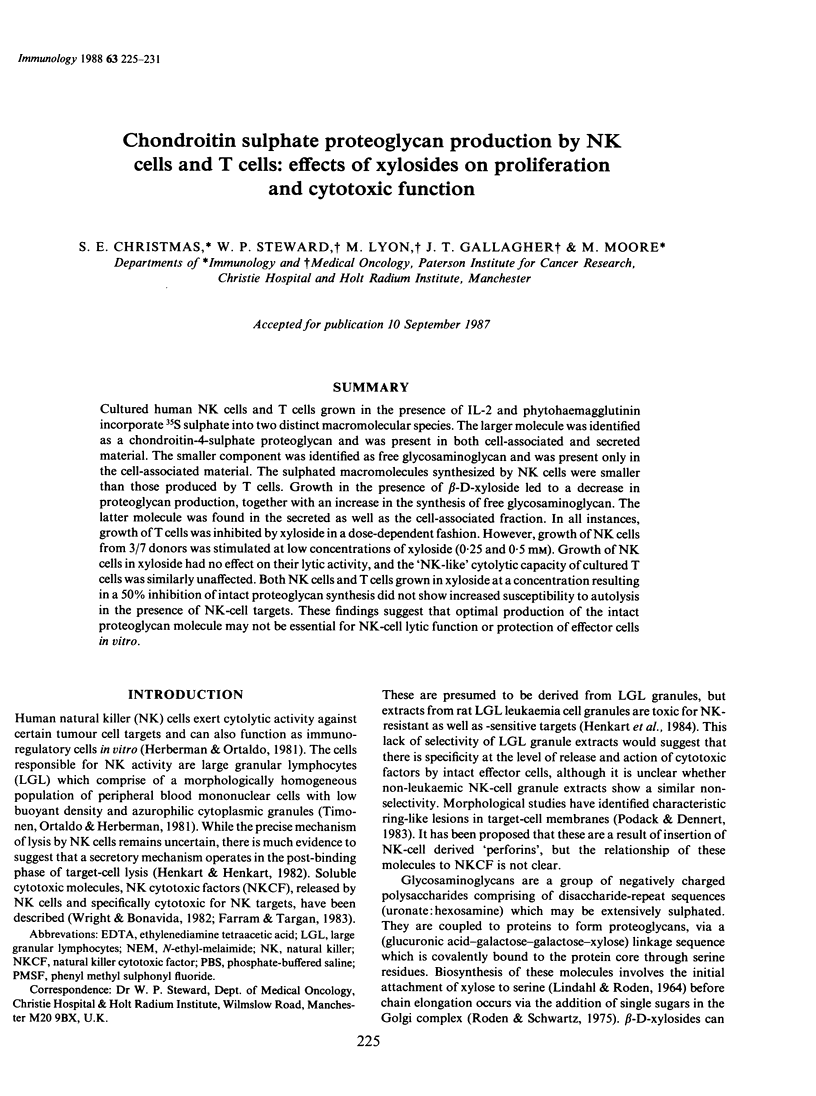
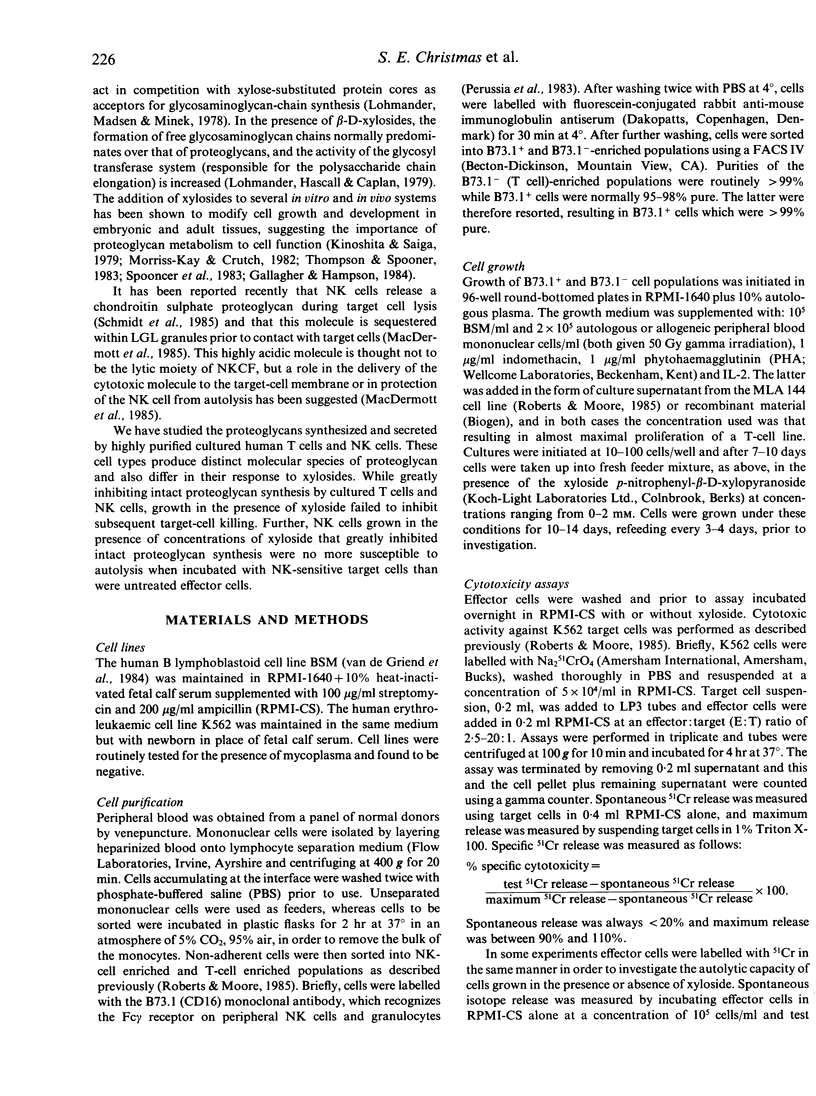
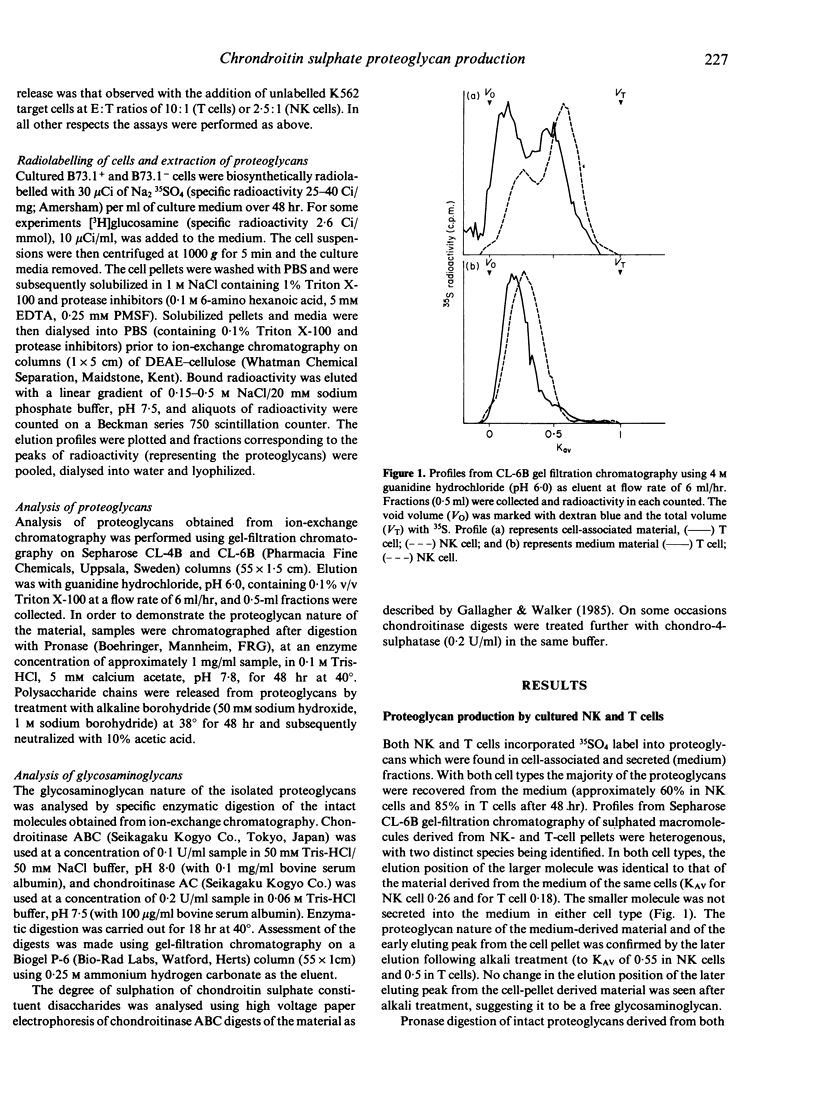
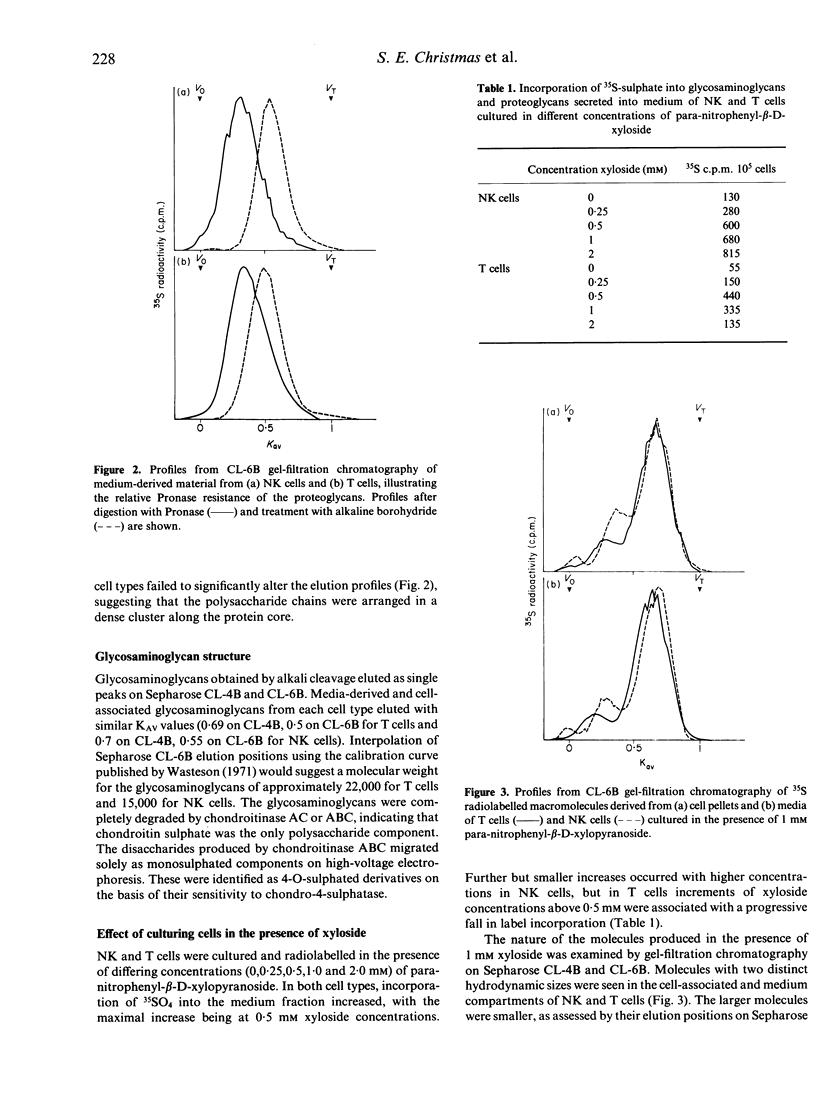
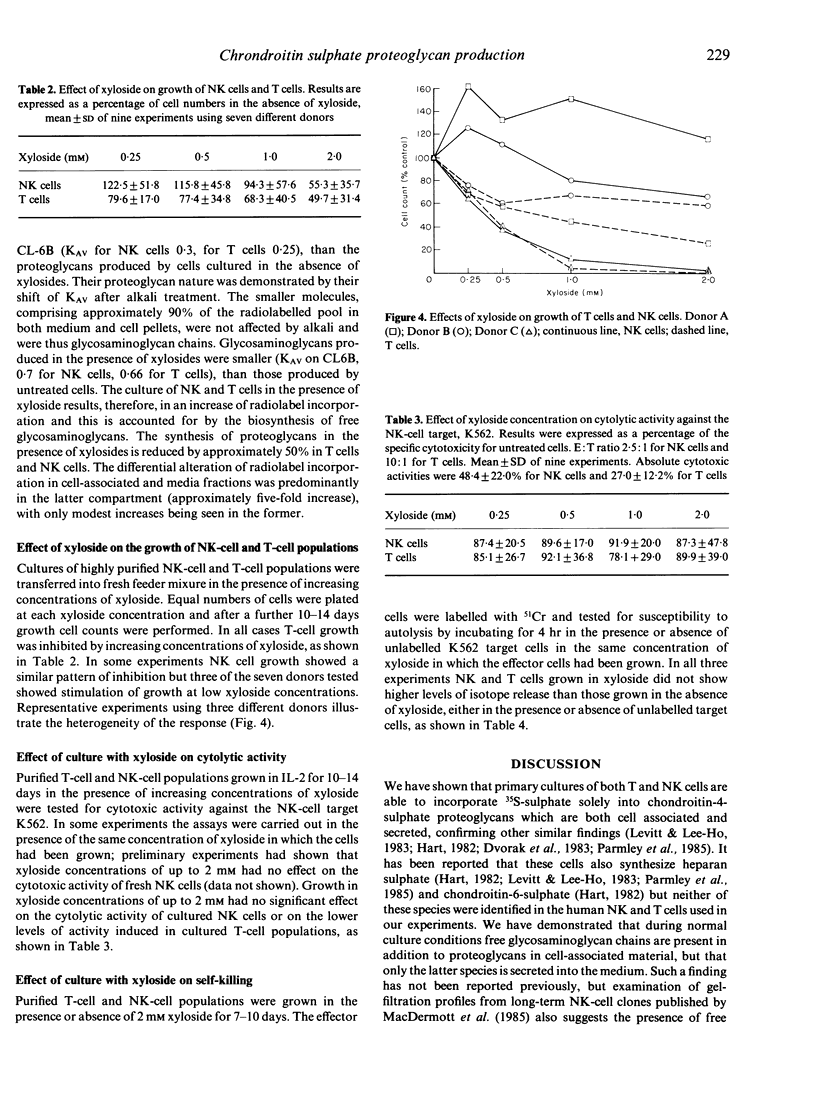
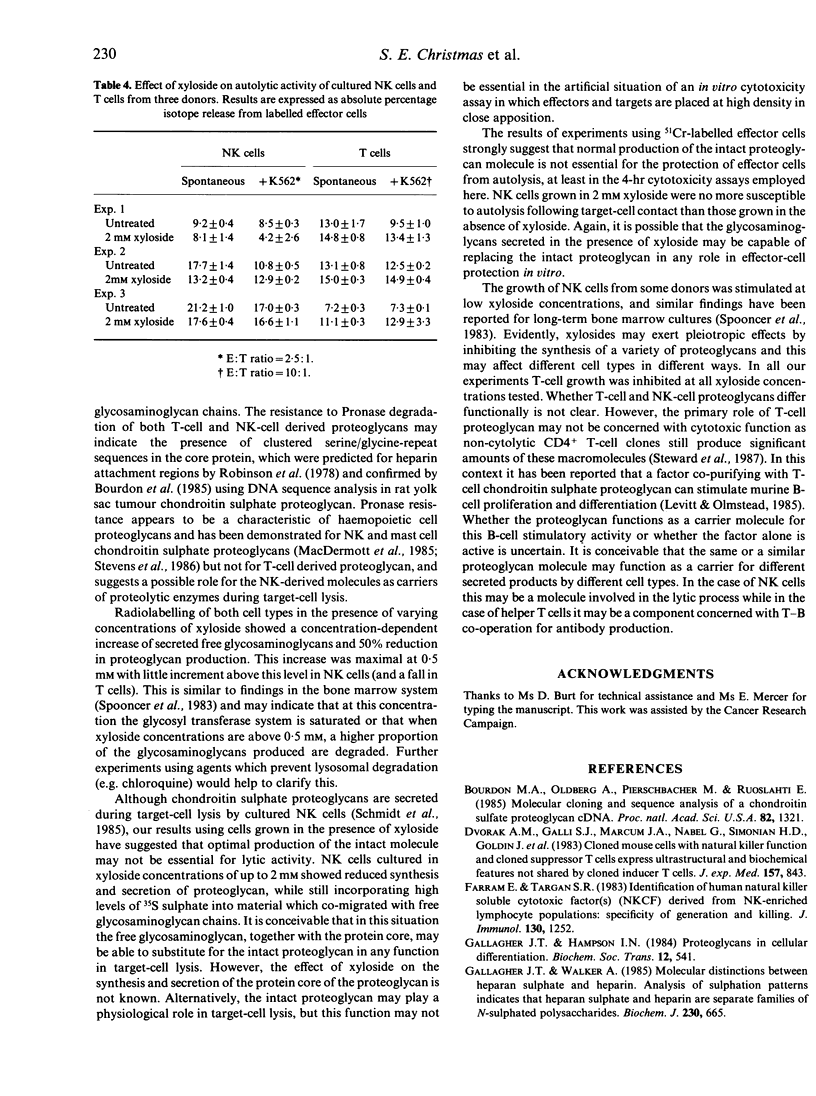
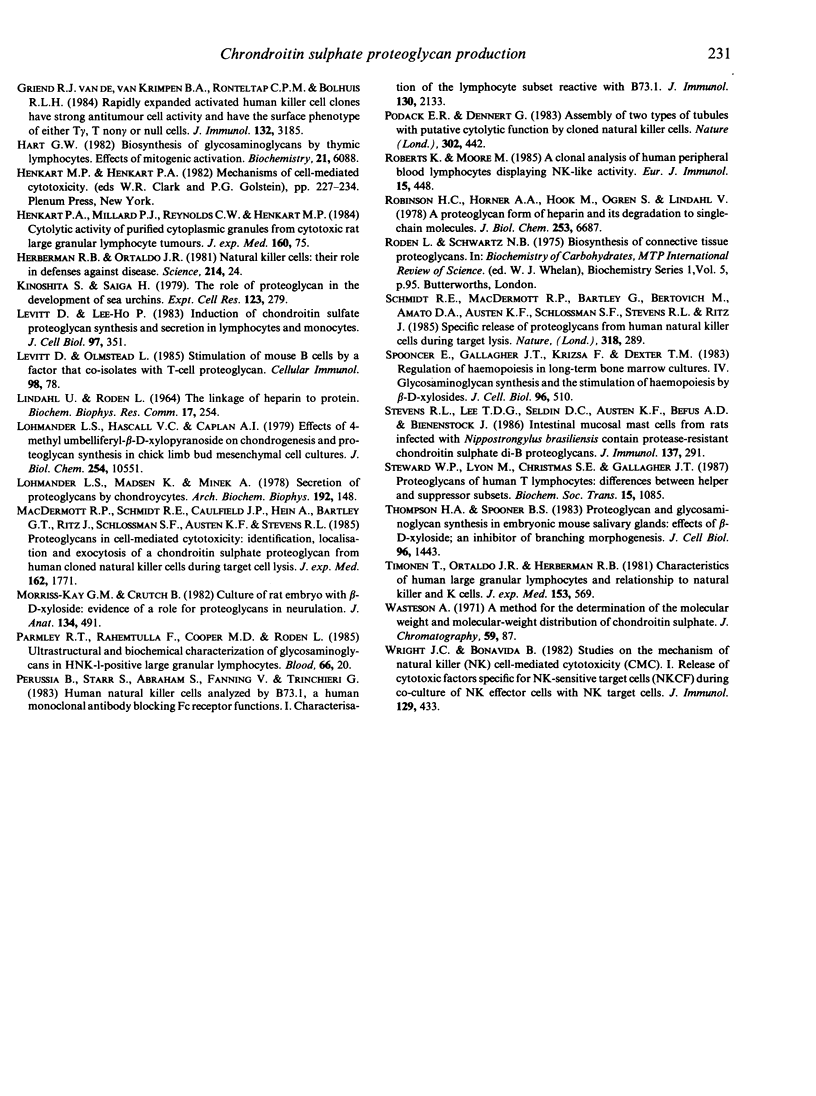
Selected References
These references are in PubMed. This may not be the complete list of references from this article.
- Bourdon M. A., Oldberg A., Pierschbacher M., Ruoslahti E. Molecular cloning and sequence analysis of a chondroitin sulfate proteoglycan cDNA. Proc Natl Acad Sci U S A. 1985 Mar;82(5):1321–1325. doi: 10.1073/pnas.82.5.1321. [DOI] [PMC free article] [PubMed] [Google Scholar]
- Dvorak A. M., Galli S. J., Marcum J. A., Nabel G., der Simonian H., Goldin J., Monahan R. A., Pyne K., Cantor H., Rosenberg R. D. Cloned mouse cells with natural killer function and cloned suppressor T cells express ultrastructural and biochemical features not shared by cloned inducer T cells. J Exp Med. 1983 Mar 1;157(3):843–861. doi: 10.1084/jem.157.3.843. [DOI] [PMC free article] [PubMed] [Google Scholar]
- Farram E., Targan S. R. Identification of human natural killer soluble cytotoxic factors (NKCF) derived from NK-enriched lymphocyte populations: specificity of generation and killing. J Immunol. 1983 Mar;130(3):1252–1256. [PubMed] [Google Scholar]
- Gallagher J. T., Hampson I. N. Proteoglycans in cellular differentiation and neoplasia. Biochem Soc Trans. 1984 Jun;12(3):541–543. doi: 10.1042/bst0120541. [DOI] [PubMed] [Google Scholar]
- Gallagher J. T., Walker A. Molecular distinctions between heparan sulphate and heparin. Analysis of sulphation patterns indicates that heparan sulphate and heparin are separate families of N-sulphated polysaccharides. Biochem J. 1985 Sep 15;230(3):665–674. doi: 10.1042/bj2300665. [DOI] [PMC free article] [PubMed] [Google Scholar]
- Hart G. W. Biosynthesis of glycosaminoglycans by thymic lymphocytes. Effects of mitogenic activation. Biochemistry. 1982 Nov 23;21(24):6088–6096. doi: 10.1021/bi00267a010. [DOI] [PubMed] [Google Scholar]
- Henkart P. A., Millard P. J., Reynolds C. W., Henkart M. P. Cytolytic activity of purified cytoplasmic granules from cytotoxic rat large granular lymphocyte tumors. J Exp Med. 1984 Jul 1;160(1):75–93. doi: 10.1084/jem.160.1.75. [DOI] [PMC free article] [PubMed] [Google Scholar]
- Levitt D., Ho P. L. Induction of chondroitin sulfate proteoglycan synthesis and secretion in lymphocytes and monocytes. J Cell Biol. 1983 Aug;97(2):351–358. doi: 10.1083/jcb.97.2.351. [DOI] [PMC free article] [PubMed] [Google Scholar]
- Levitt D., Olmstead L. Stimulation of mouse B cells by a factor that coisolates with T-cell proteoglycan. Cell Immunol. 1986 Mar;98(1):78–92. doi: 10.1016/0008-8749(86)90269-8. [DOI] [PubMed] [Google Scholar]
- Lindahl U., Rodén L. The linkage of heparin to protein. Biochem Biophys Res Commun. 1964 Oct 14;17(3):254–259. doi: 10.1016/0006-291x(64)90393-6. [DOI] [PubMed] [Google Scholar]
- Lohmander L. S., Hascall V. C., Caplan A. I. Effects of 4-methyl umbelliferyl-beta-D-xylopyranoside on chondrogenesis and proteoglycan synthesis in chick limb bud mesenchymal cell cultures. J Biol Chem. 1979 Oct 25;254(20):10551–10561. [PubMed] [Google Scholar]
- Lohmander S., Madsen K., Hinek A. Secretion of proteoglycans by chondrocytes. Influence of colchicine, cytochalasin B, and beta-D-xyloside. Arch Biochem Biophys. 1979 Jan;192(1):148–157. doi: 10.1016/0003-9861(79)90080-8. [DOI] [PubMed] [Google Scholar]
- MacDermott R. P., Schmidt R. E., Caulfield J. P., Hein A., Bartley G. T., Ritz J., Schlossman S. F., Austen K. F., Stevens R. L. Proteoglycans in cell-mediated cytotoxicity. Identification, localization, and exocytosis of a chondroitin sulfate proteoglycan from human cloned natural killer cells during target cell lysis. J Exp Med. 1985 Dec 1;162(6):1771–1787. doi: 10.1084/jem.162.6.1771. [DOI] [PMC free article] [PubMed] [Google Scholar]
- Morriss-Kay G. M., Crutch B. Culture of rat embryos with beta-D-xyloside: evidence of a role for proteoglycans in neurulation. J Anat. 1982 May;134(Pt 3):491–506. [PMC free article] [PubMed] [Google Scholar]
- Perussia B., Starr S., Abraham S., Fanning V., Trinchieri G. Human natural killer cells analyzed by B73.1, a monoclonal antibody blocking Fc receptor functions. I. Characterization of the lymphocyte subset reactive with B73.1. J Immunol. 1983 May;130(5):2133–2141. [PubMed] [Google Scholar]
- Podack E. R., Dennert G. Assembly of two types of tubules with putative cytolytic function by cloned natural killer cells. 1983 Mar 31-Apr 6Nature. 302(5907):442–445. doi: 10.1038/302442a0. [DOI] [PubMed] [Google Scholar]
- Roberts K., Moore M. A clonal analysis of human peripheral blood lymphocytes displaying natural killer-like activity. Eur J Immunol. 1985 May;15(5):448–456. doi: 10.1002/eji.1830150507. [DOI] [PubMed] [Google Scholar]
- Robinson H. C., Horner A. A., Hök M., Ogren S., Lindahl U. A proteoglycan form of heparin and its degradation to single-chain molecules. J Biol Chem. 1978 Oct 10;253(19):6687–6693. [PubMed] [Google Scholar]
- Schmidt R. E., MacDermott R. P., Bartley G., Bertovich M., Amato D. A., Austen K. F., Schlossman S. F., Stevens R. L., Ritz J. Specific release of proteoglycans from human natural killer cells during target lysis. Nature. 1985 Nov 21;318(6043):289–291. doi: 10.1038/318289a0. [DOI] [PubMed] [Google Scholar]
- Spooncer E., Gallagher J. T., Krizsa F., Dexter T. M. Regulation of haemopoiesis in long-term bone marrow cultures. IV. Glycosaminoglycan synthesis and the stimulation of haemopoiesis by beta-D-xylosides. J Cell Biol. 1983 Feb;96(2):510–514. doi: 10.1083/jcb.96.2.510. [DOI] [PMC free article] [PubMed] [Google Scholar]
- Stevens R. L., Lee T. D., Seldin D. C., Austen K. F., Befus A. D., Bienenstock J. Intestinal mucosal mast cells from rats infected with Nippostrongylus brasiliensis contain protease-resistant chondroitin sulfate di-B proteoglycans. J Immunol. 1986 Jul 1;137(1):291–295. [PubMed] [Google Scholar]
- Thompson H. A., Spooner B. S. Proteoglycan and glycosaminoglycan synthesis in embryonic mouse salivary glands: effects of beta-D-xyloside, an inhibitor of branching morphogenesis. J Cell Biol. 1983 May;96(5):1443–1450. doi: 10.1083/jcb.96.5.1443. [DOI] [PMC free article] [PubMed] [Google Scholar]
- Timonen T., Ortaldo J. R., Herberman R. B. Characteristics of human large granular lymphocytes and relationship to natural killer and K cells. J Exp Med. 1981 Mar 1;153(3):569–582. doi: 10.1084/jem.153.3.569. [DOI] [PMC free article] [PubMed] [Google Scholar]
- Wright S. C., Bonavida B. Studies on the mechanism of natural killer (NK) cell-mediated cytotoxicity (CMC). I. Release of cytotoxic factors specific for NK-sensitive target cells (NKCF) during co-culture of NK effector cells with NK target cells. J Immunol. 1982 Jul;129(1):433–439. [PubMed] [Google Scholar]
- van de Griend R. J., van Krimpen B. A., Ronteltap C. P., Bolhuis R. L. Rapidly expanded activated human killer cell clones have strong antitumor cell activity and have the surface phenotype of either T gamma, T-non-gamma, or null cells. J Immunol. 1984 Jun;132(6):3185–3191. [PubMed] [Google Scholar]


